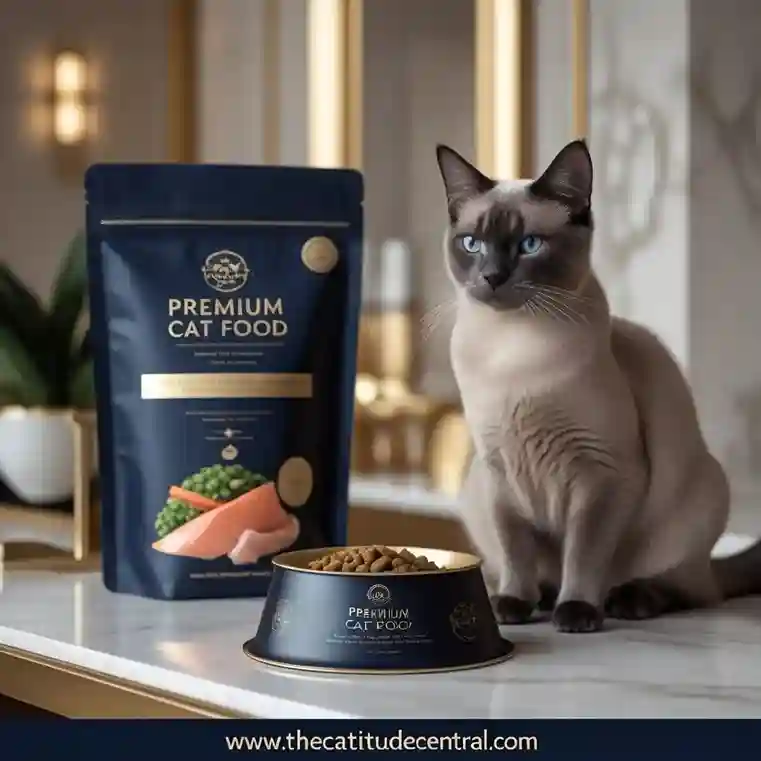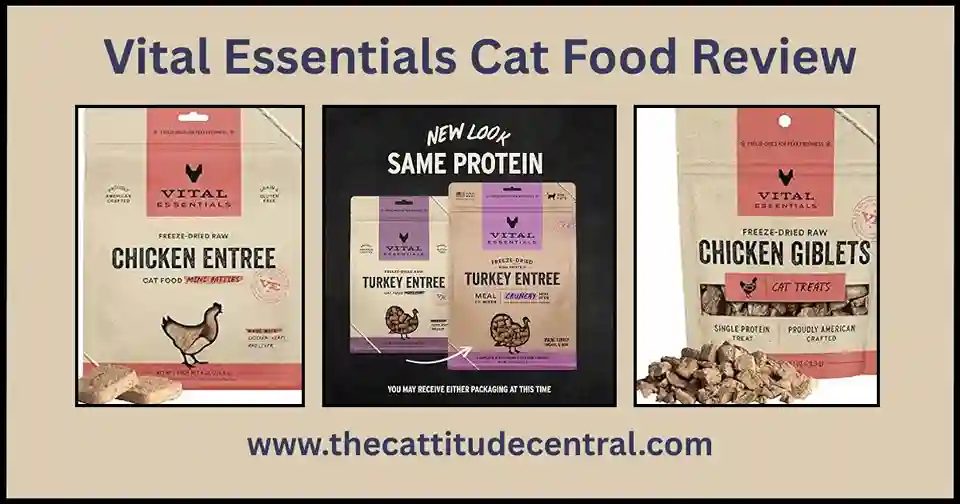As a cat parent, you want the best for your furry companion. From cozy beds to interactive toys, you go above and beyond to ensure your cat lives a happy, healthy life. But when it comes to their diet, are you making the right choice? Enter natural cat food—a game-changer in feline nutrition that’s gaining popularity among pet owners who prioritize quality and wellness.
In this ultimate guide, we’ll dive deep into what natural cat food is, why it matters, and how it can transform your cat’s health. From decoding ingredient labels to exploring the best brands, we’ve got you covered with everything you need to make informed decisions for your feline friend. Let’s get started!
What is Natural Cat Food?
Natural cat food is formulated with high-quality, minimally processed ingredients that mimic a cat’s natural diet in the wild. Unlike conventional cat foods that may contain artificial additives, fillers, or low-quality proteins, natural cat food prioritizes wholesome, nutrient-rich components.
According to the Association of American Feed Control Officials (AAFCO), “natural” pet food must be free from artificial flavors, colors, or preservatives. However, the term “natural” can sometimes be misleading, as it’s not as strictly regulated as “organic.” To ensure you’re choosing truly natural cat food, look for brands that are transparent about their sourcing and manufacturing processes.
Natural cat food often includes:
- High-quality animal proteins (e.g., chicken, turkey, or fish) as the primary ingredient.
- Whole grains or grain-free options like brown rice or sweet potatoes for digestible carbs.
- Natural preservatives like vitamin E or rosemary extract.
- Fruits and vegetables for added vitamins and antioxidants.
By focusing on these ingredients, natural cat food provides a balanced diet that supports your cat’s overall well-being.
Why Choose Natural Cat Food for Your Cat?
Cats are obligate carnivores, meaning their bodies are designed to thrive on a diet rich in animal-based proteins. In the wild, cats hunt prey like birds and small mammals, consuming nutrient-dense meals that fuel their energy and maintain their health. Unfortunately, many commercial cat foods fall short of meeting these biological needs, relying on cheap fillers and artificial ingredients that can harm your cat over time.
Natural cat food bridges this gap by offering a diet closer to what nature intended. Here’s why making the switch is worth it:
- Better Nutrition: Natural cat food is packed with bioavailable nutrients that support your cat’s immune system, coat, and digestion.
- Fewer Health Issues: By avoiding artificial additives and low-quality ingredients, natural cat food reduces the risk of allergies, obesity, and chronic diseases.
- Improved Longevity: A nutrient-rich diet can help your cat live a longer, healthier life.
- Happier Cats: Cats on natural diets often have more energy, shinier coats, and better moods—making playtime even more fun!
As a cat owner, choosing natural cat food is an investment in your pet’s future. It’s about giving them the foundation they need to thrive.
Key Benefits of Natural Cat Food
Let’s break down the specific benefits of natural cat food and how they impact your cat’s health:
Enhanced Digestive Health
Natural cat food often contains easily digestible ingredients like whole proteins and fiber-rich vegetables. This reduces the strain on your cat’s digestive system, leading to fewer issues like vomiting, diarrhea, or constipation. Probiotics and prebiotics, commonly found in premium natural cat foods, further support gut health.
Healthier Skin and Coat
Omega-3 and omega-6 fatty acids, found in ingredients like salmon oil or flaxseed, promote a glossy coat and healthy skin. If your cat struggles with dry skin or excessive shedding, a natural diet can make a noticeable difference.
Stronger Immune System
Antioxidants from fruits and vegetables (e.g., blueberries, spinach) help combat free radicals, boosting your cat’s immune system. A strong immune system means fewer vet visits and a better ability to fight off infections.
Weight Management
Natural cat food is often lower in empty calories from fillers like corn or soy. This helps maintain a healthy weight, reducing the risk of obesity-related conditions like diabetes or joint issues.
Reduced Allergies
Many cats develop food sensitivities to artificial ingredients or low-quality proteins. Natural cat food eliminates these triggers, making it ideal for cats with allergies or sensitive stomachs.
These benefits add up to a happier, healthier cat—and a more relaxed cat parent!
Understanding Cat Food Labels: What to Look For
Reading cat food labels can feel like decoding a foreign language, but it’s essential for choosing the best natural cat food. Here are key things to look for:
- Named Protein Source: The first ingredient should be a specific protein like “chicken” or “salmon,” not vague terms like “meat” or “poultry by-products.”
- “Complete and Balanced” Statement: Look for an AAFCO statement confirming the food meets nutritional standards for your cat’s life stage (kitten, adult, or senior).
- Natural Preservatives: Ingredients like mixed tocopherols (vitamin E) or ascorbic acid (vitamin C) are safe, natural preservatives.
- Minimal Fillers: Avoid foods with excessive corn, wheat, or soy, which offer little nutritional value.
- No Artificial Additives: Steer clear of artificial colors (e.g., Red 40), flavors, or preservatives like BHA/BHT.
Pro Tip: Check the ingredient list length. Shorter lists often indicate simpler, higher-quality recipes.
Ingredients to Avoid in Cat Food
Not all cat foods are created equal. To ensure you’re choosing a truly natural option, watch out for these red flags:
- By-Products: These are low-quality leftovers (e.g., feathers, beaks) that lack nutritional value.
- Artificial Preservatives: BHA, BHT, and ethoxyquin are linked to health risks in pets.
- Fillers: Corn, wheat, and soy are cheap fillers that can cause digestive issues or allergies.
- Artificial Colors and Flavors: Cats don’t care about the color of their food, and these additives can trigger sensitivities.
- Added Sugars: Ingredients like corn syrup or molasses are unnecessary and can contribute to obesity.
By avoiding these ingredients, you’ll ensure your cat’s diet is as natural and wholesome as possible.
Top Natural Cat Food Brands to Consider
With so many options on the market, choosing the right natural cat food can be overwhelming. Here are five highly rated brands known for their quality and transparency:
- Orijen: Known for its biologically appropriate recipes, Orijen uses fresh, regional ingredients and high protein content to mimic a cat’s natural diet.
- Acana: A sister brand to Orijen, Acana offers premium natural cat food with a focus on whole-prey ratios and limited carbs.
- Wellness CORE: This grain-free brand emphasizes protein-rich formulas with natural ingredients like turkey, chicken, and cranberries.
- Blue Buffalo Wilderness: Inspired by the lynx’s diet, this brand offers high-protein, grain-free options with natural antioxidants.
- Instinct by Nature’s Variety: Instinct specializes in raw and minimally processed foods, perfect for cats with sensitive stomachs.
Always consult your veterinarian before switching brands, especially if your cat has specific dietary needs.
Wet vs. Dry Natural Cat Food: Which is Better?
One of the biggest debates among cat owners is whether wet or dry natural cat food is the better choice. Let’s compare:
Wet Natural Cat Food
- Pros: Higher moisture content (great for hydration), closer to a cat’s natural diet, often more palatable.
- Cons: More expensive, shorter shelf life once opened, can contribute to dental plaque if not paired with dental care.
- Best For: Cats with urinary issues, picky eaters, or those needing extra hydration.
Dry Natural Cat Food
- Pros: Convenient, cost-effective, longer shelf life, may help reduce tartar buildup.
- Cons: Lower moisture content, less appealing to some cats, higher carb content in some brands.
- Best For: Budget-conscious owners or cats with healthy hydration habits.
Many experts recommend a combination of wet and dry food to balance nutrition, hydration, and dental health. Experiment to see what works best for your cat.
Transitioning Your Cat to a Natural Diet
Switching your cat to natural cat food requires a gradual approach to avoid digestive upset. Follow these steps:
- Days 1-3: Mix 25% new natural cat food with 75% old food.
- Days 4-6: Increase to 50% new food and 50% old food.
- Days 7-9: Use 75% new food and 25% old food.
- Day 10: Fully transition to 100% natural cat food.
Monitor your cat for signs of digestive issues (e.g., vomiting, diarrhea) during the transition. If problems persist, consult your vet.
Pro Tip: Cats can be picky, so try warming wet food slightly or mixing in a bit of tuna juice to make the new food more enticing.
Homemade Natural Cat Food: Is It Worth It?
Some cat owners opt to make their own natural cat food for full control over ingredients. While this can be rewarding, it’s not without challenges.
Benefits of Homemade Cat Food
- Customizable: Tailor recipes to your cat’s preferences or health needs.
- Fresh Ingredients: Use high-quality, human-grade meats and vegetables.
- No Additives: Avoid artificial ingredients entirely.
Challenges
- Nutritional Balance: Cats require specific nutrients (e.g., taurine, vitamin A) that are hard to balance without expert guidance.
- Time-Consuming: Preparing fresh meals regularly can be labor-intensive.
- Risk of Contamination: Improper handling of raw meat can lead to bacterial issues.
If you’re considering homemade cat food, work with a veterinary nutritionist to ensure your recipes meet AAFCO guidelines. Alternatively, consider freeze-dried or raw natural cat food brands as a safer middle ground.
FAQs About Natural Cat Food
Q: Is natural cat food the same as organic cat food?
A: No. Natural cat food is minimally processed and free from artificial additives, while organic cat food must meet strict USDA standards for organic certification, including how ingredients are grown and processed.
Q: Can natural cat food help with my cat’s allergies?
A: Yes, by eliminating common allergens like artificial additives or fillers, natural cat food can reduce symptoms in cats with food sensitivities.
Q: Is grain-free natural cat food better?
A: Not necessarily. While grain-free is beneficial for cats with grain allergies, whole grains like brown rice can be a healthy carb source for others. Consult your vet to decide.
Q: How much does natural cat food cost?
A: Prices vary, but natural cat food is often pricier than conventional brands. Expect to pay $1–$3 per pound for dry food and $0.50–$2 per can for wet food.
Q: Can kittens eat natural cat food?
A: Yes, but choose formulas labeled for kittens to ensure they meet the higher nutritional needs of growing cats.
Conclusion: Make the Switch to Natural Cat Food Today
Your cat deserves a diet that fuels their energy, supports their health, and keeps their tail wagging (or at least swishing!). Natural cat food is more than a trend—it’s a commitment to giving your feline friend the best possible nutrition. By choosing high-quality ingredients, avoiding harmful additives, and tailoring their diet to their needs, you’re setting your cat up for a long, vibrant life.
Ready to make the switch? Start by researching reputable natural cat food brands, reading labels carefully, and consulting your veterinarian for personalized advice. Your cat will thank you with every purr, pounce, and cuddle.
Have questions about natural cat food or want to share your cat’s success story? Drop a comment below or join our community of cat lovers on social media!



